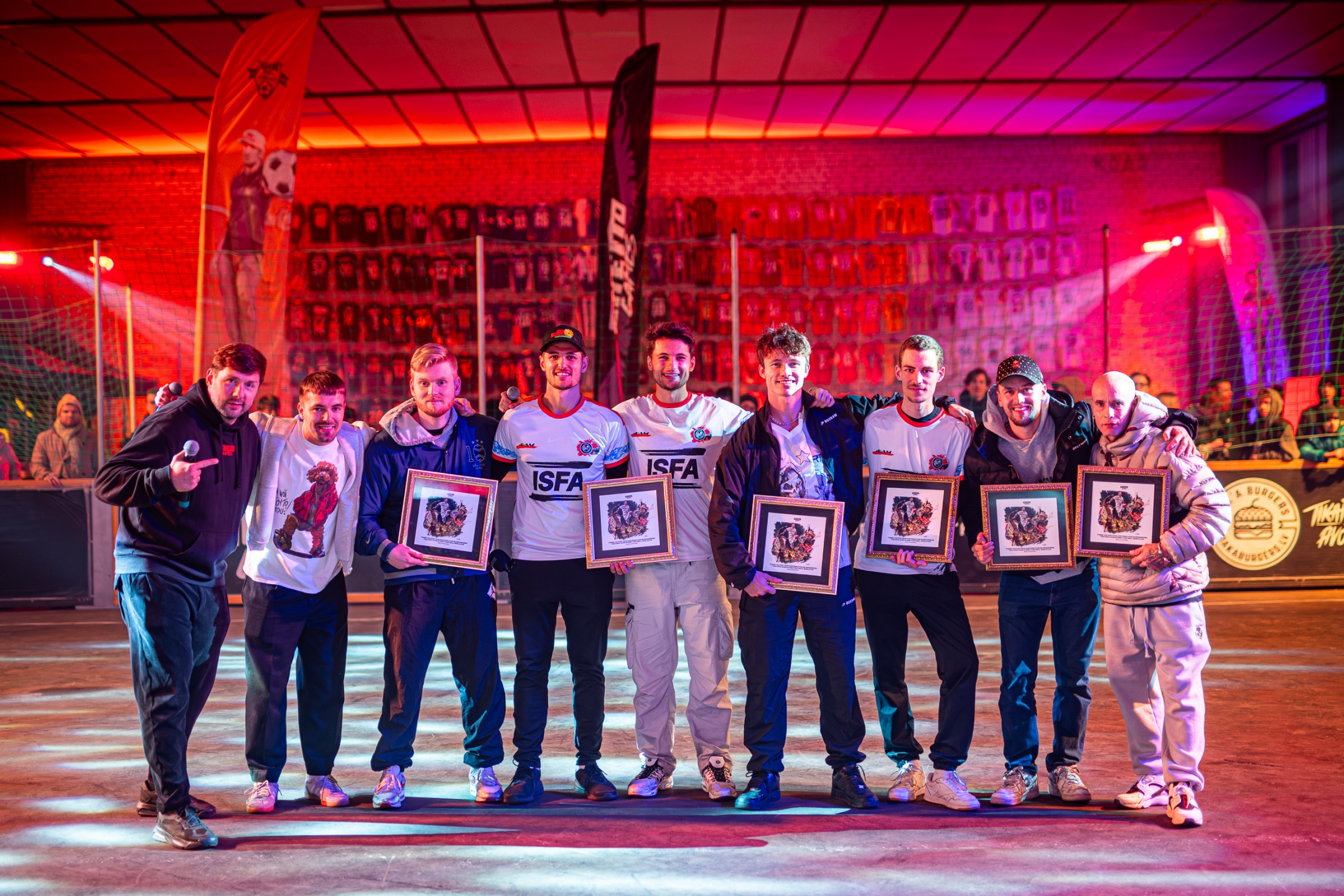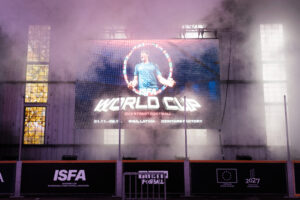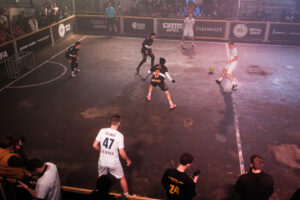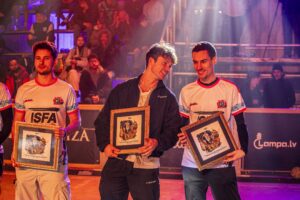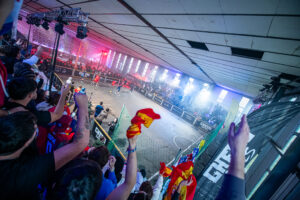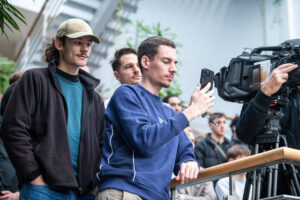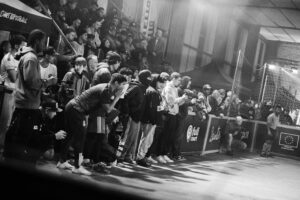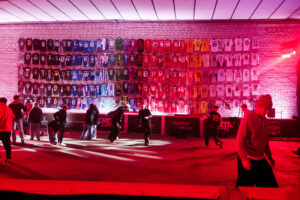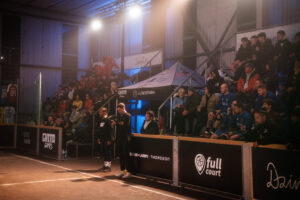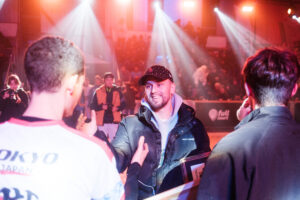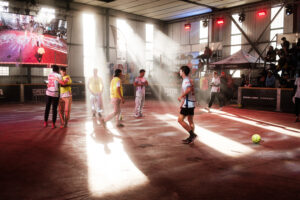We Organised The First Official Street Football World Cup
- November 3, 2024
- Riga, Latvia
- Vince Van de Vreken
This past week, we made history by organizing the first-ever ISFA 3V3 Street Football World Cup in collaboration with Ghetto Games in Riga, Latvia. A total of 30 countries were represented by a crew, each earning their spot in a unique way through local and national qualification tournaments throughout the year.
Participating Crews: Street City (Australia), Kings of Klessheim (Austria), Joga3 (Belgium), Pulinho Street (Brazil), Prijedor (Bosnia and Herzegovina), Street Masters Chile, Street Soul China, Medellin Callejeros (Colombia), Matina Ekipa (Croatia), Pannahouse (Denmark), Street Pharaohs (Egypt), Kings5s (England), Yökoris (Finland), S3 (France), StreetsoccerHH (Germany), Guinness (Ireland), BojanoMundial (Italy), Street Japan, FC San Andreas (Kyrgyzstan), Nike Strike (Latvia), GOATS (Mexico), Panna Nepal, Street Kings (Netherlands), R-Style (Poland), Solar-M (Serbia), Panna Studio (South Korea), AEFC (Spain), Streets of Sweden, Gennecy Bricks (Switzerland), San Diego FC (United States).
The Journey to Riga
In late August, we contacted Jugador, with whom we made the limited edition shirts for the ISFA trips to Marseille and Bojano. They wanted to contribute to the project, providing customised jerseys for each team, but time was ticking as the designs were being made and lead time to start production was coming closer with not all countries’ participation yet confirmed. We eventually managed to have them directly shipped to Riga for almost all teams. Huge shoutout to Mohammed and Zakaria from Jugador for believing in the project and sponsoring the event. And their incredibly talented shirt designer Syafiq.
By early September – two months before the World Cup – 70% of the teams were confirmed. Our original plan was to have 32 teams, but visa and financial issues forced some to withdraw. We found last-minute replacements for most, bringing the final count to 30 teams.
Early October, we started announcing each team on our social media with personalized posts and videos of the players in action.
Finding a Venue
Fun fact: three weeks before the tournament, we didn’t have a suitable location. In the cold city of Riga, an indoor space was certainly needed. For several months, we tried to secure Riga’s Central Market, an old zeppelin hangar that perfectly matched with our main requirements of being in the busy city centre and having a street vibe. But due to delayed renovation works, it got cancelled. Antons searched for many alternatives: shopping centres, hangars and even karting halls. It wasn’t until we spoke to Ghetto’s sponsor, Dzintars Cosmetics, that we finally found a suitable alternative location:
After announcing the location, I added it to Google Maps to make it easier for players and spectators to navigate:
Fun fact 2: Collectively, all 30 teams together have travelled more kilometres to Riga than Neil Armstrong did going to the moon.
Rethinking Referees
Street football is built on respect and fair play, which is why we’ve always believed it doesn’t need referees. But a youth tournament at Kings Dome (Amsterdam) two weeks before the World Cup changed our minds – without mics or even a whistle, small disputes arose. To avoid similar issues, we decided to bring in four referees: two from Latvia, one from the Netherlands, and one from Italy.
We also realized our 3V3 Street Football rules needed some more tweaking, because of certain unique situations happening. It’s all part of the process – trial and error, improving 1% at a time.
Monday, October 28: Arriving in Riga
I packed my bags, took an early flight from Brussels, and was picked up by Antons at the airport. Our first stop was the Ghetto Games office, where we met up with Liicht, Martins, Janis and other members of the Ghetto family. Over lunch at Rimi Olympic Center, Antons introduced us to an indoor football facility from the Latvian Football Federation – one of only two such facilities in the entire country. Ghetto uses it for their “3pret3” youth competition where they prepare the next generation of street football players.
Later, we settled into our Airbnb, where Liicht took a power nap while I worked on content, because it was time to announce the last three teams. That night, Jannes (who had joined us last-minute from Georgia) and Jovan arrived with three bags full of jerseys for the legendary Wall of Passion – an idea from the Kings of Klessheim community that has become a signature of ISFA events worldwide.
We ended the day with kebab at KEBAB House before calling it a night.
Tuesday, October 29: First Look at the Venue
The morning kicked off with Raimonds aka “Ghetto Daddy” (yes, it’s in his IG bio, I didn’t make it up) and Antons doing a promo tour – first stop: national television, then a radio interview. Meanwhile, we turned Innocent Café into the ISFA office for the day, finalizing the Tournify event page, which included: general information like a map on how to get to the event, tournament schedule, links for tickets, livestream, ruleset, contact information, afterparty location etc. Nenad and Josh arrived and joined our group.
Teams from Brazil and Australia arrived and we captured content with them. At the same time, we tried to solve some logistic issues. Colombia was stuck in Paris and Kyrgyzstan’s flight got cancelled – forcing last-minute schedule changes.
Later, we visited the venue for the first time. Packed eight people into a seven-seater car, street football style. It was located in the Dzintars Factory domain which looked like a map of Call of Duty: Black Ops 2 in real life. We recorded a video with our first impressions and helped the Ghetto team unloading the stands from their truck. They kept working until late at night using the car lights.
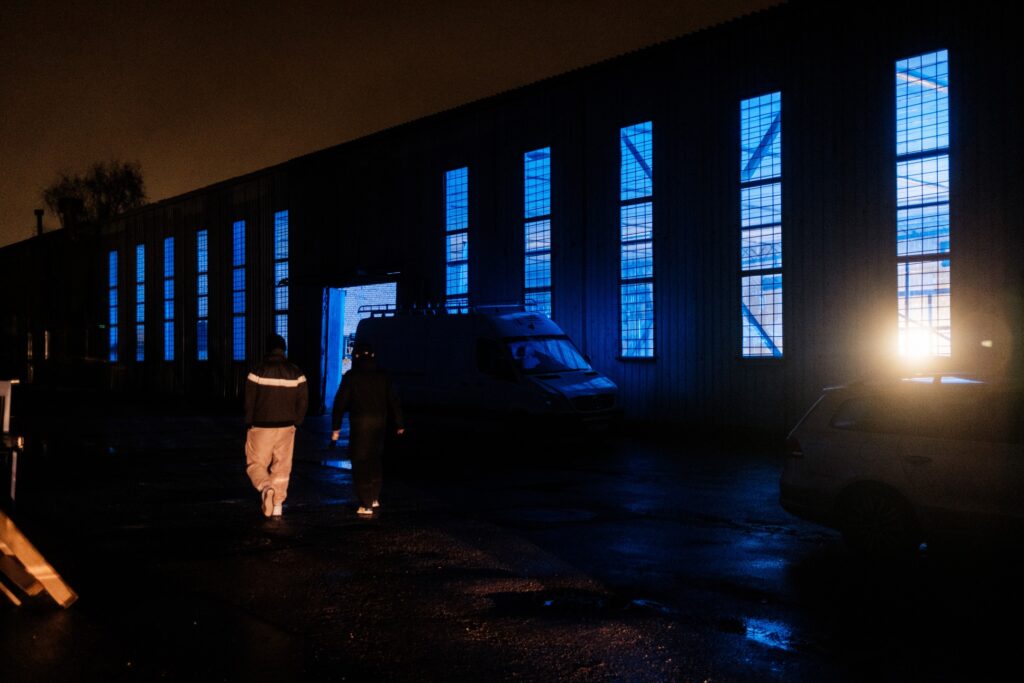
At night, we played pick-up in Riga’s Old Town with Vini, Gui and Mourão from Brazil and picked up Team Japan from the airport. Dinner? Kebab again – this time at Yummy Kebabs.
That night, Egypt informed us that only two players had made the trip. We uploaded a group picture to ChatGPT and asked who of us looked the most Egyptian. Guess what? Nenad ended up playing for Egypt.
Wednesday, October 30: Group Draw
Antons picked us up and we headed to the Ghetto Office to finalize preparations for the group draw, which was set to take place at the Riga Freeport Authority building at 2 PM. We decided to livestream the draw on both the ISFA and Ghetto Football Instagram accounts, setting up an advanced dual-camera setup – one angle capturing the group overview and another one following the speakers with a wireless microphone. A camera crew from Latvia’s public broadcaster, LSM, was also present to document the event.
Several teams that had already arrived in Riga joined us for the draw. Once the groups were finalized, we created graphics and a video discussing the results. We had lunch at the venue’s cafeteria, followed by a nice walk in the fresh air back to the Airbnb. With the tournament getting closer, we worked on a document containing key information about each team, including player backgrounds, strengths and playing styles, for the commentators to use.
One burned pizza in the oven later, we wrapped up the evening with another pick-up session in Riga’s Old Town, this time linking up with Team USA.
Thursday, October 31: World Cup Practice
With just one day before the tournament, we released a detailed schedule covering the next two days, making some last-minute adjustments after Kyrgyzstan’s delayed arrival. This led to the idea of hosting an official opening match.
At the Ghetto Office, after a quick push-up session with Raimonds, Nenad prepared a content plan to use during the event. Josh made a list of Instagram usernames from all teams and players, making it easier for the content team to tag and engage with everyone involved. Meanwhile, I scheduled the livestreams on the ISFA YouTube channel – just in time, as we realized that YouTube requires up to 24 hours to activate the livestream feature if it’s not used before.
Next, we headed to a shopping mall on a rather unusual mission – finding 300 clothing hangers for the iconic Wall of Passion. We walked into multiple stores, explaining our request to confused store employees. Result: 17 hangers which wasn’t even close, but Antons’ had a plan B up his sleeve. After securing the hangers, we went to the event venue to meet with the livestream technician Miks, who would oversee the production.
In the meantime, we moved to our second Airbnb – a spacious house on the outskirts of Riga that could accommodate around 15 people, just a five-minute Bolt ride from the tournament venue. I stayed there with the Austrian team (Ilyas, Fedi, and Gigi) along with Jovan, Nenad, Julian, Jannes, Quang, the Dutch team (Jim, Zohair, Nikzad, and Ufuk) and referee Lennard. As street as it gets.
From 9 PM until midnight, we held a World Cup practice session for the teams at Riga’s Futsal Club. With the others still at the tournament venue making final preparations for the big day, Josh and I took the lead in organizing the session. We started by setting up goals using backpacks before replacing them with BazookaGoals. The training consisted of pick-up games – five-minute rounds or first to two goals – playing 3v3 and 4v4 so teams could test strategies without revealing too much to their rivals.
Jannes and I ordered food and true to my reputation as the slowest eater of all time, I took my time finishing it.
Meanwhile, the rest of the team worked late into the night preparing the venue. Jovan, Nenad and the crew stayed up until 5:30 AM, hanging jerseys on the wall to complete the setup. Is it a flex that my number 7 jersey is on the top row right next to Issy “Hitman” Hamdaoui? Because it sure feels like one.
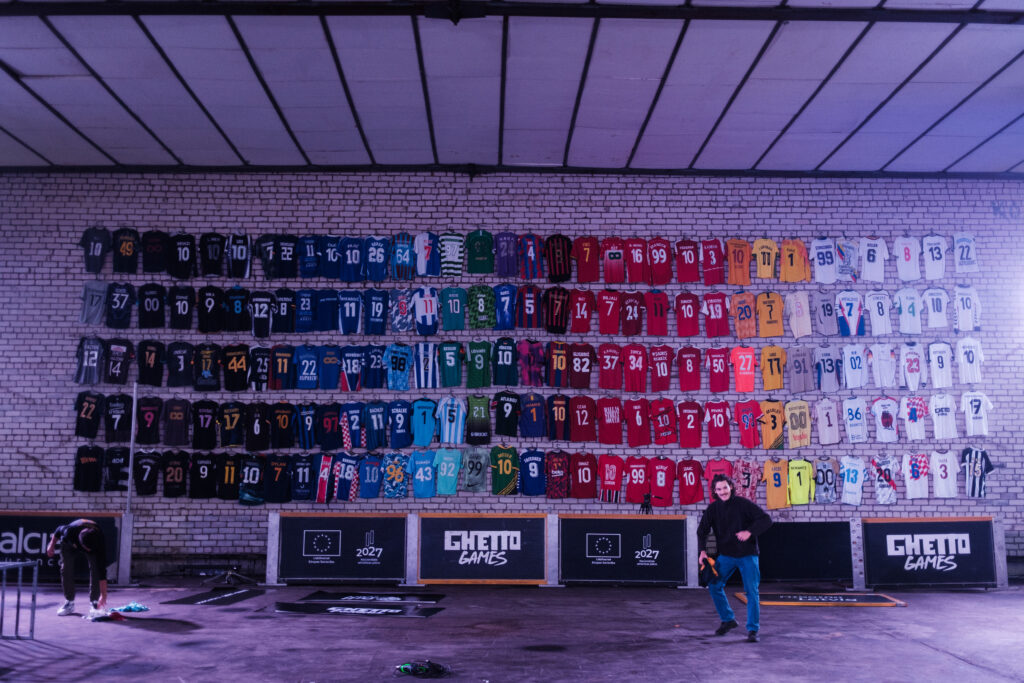
Friday, November 1: World Cup Day 1 - Group Stage
The day we had been preparing for so long had finally arrived. Early in the morning, Julian, Lennard and I made a quick stop at a local supermarket to stock up on supplies. By 8:30 AM, we were finalizing the last details: I ensured, together with Lennard (head of referees), that the balls were pumped to the correct pressure. Jannes and I brushed the pitch once more and dried it, as heavy rainfall had exposed leaks in the venue’s roof. The boardings around the pitch were set up and for the first time, we used chalk instead of tape for the field markings – an idea that would later prove problematic. The DJs, light engineer and special effects team were ready. The livestream was set up and the venue featured a wall of jerseys, a big screen that would later be used for VAR checks. Liicht and I had a final briefing with the referees, clarifying any questions they might have.
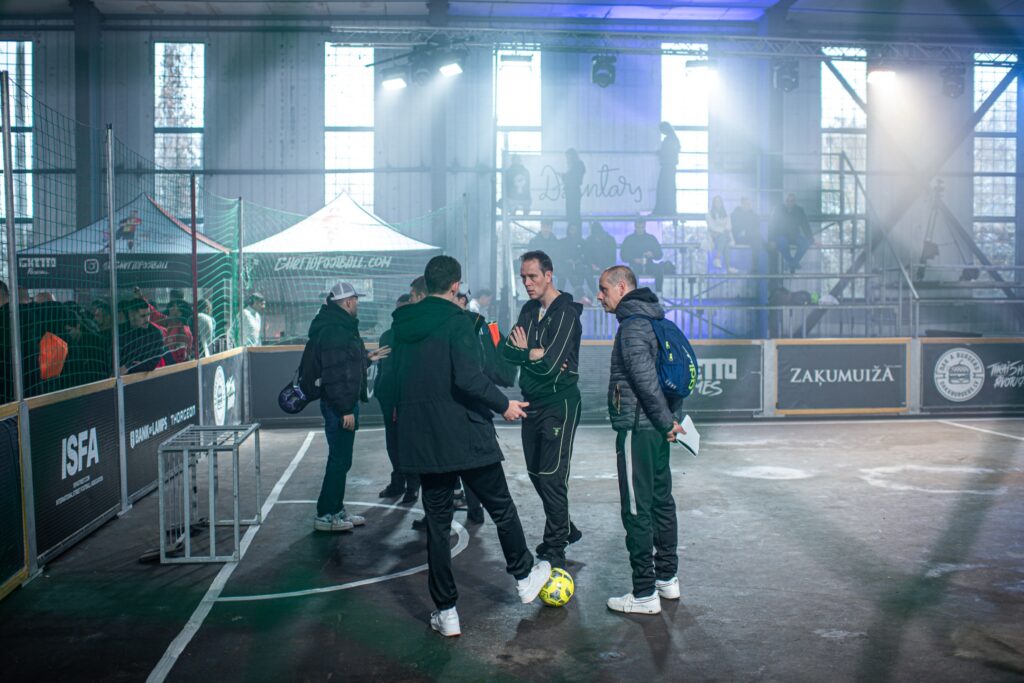
Players arrived at noon and received their Jugador jerseys. Individual and team photos were taken. At 1 PM, we held a player briefing and the gates opened for visitors. Edward arrived just in time for the games to kick off at 2 PM.
I mainly focused on filming all day, while managing Pitch 1, to capture a second-angle perspective for short-form content. Shoutout Julian for bringing me a burger with fries. Which brings me to another thing we didn’t think through enough, the lack of halal food options.
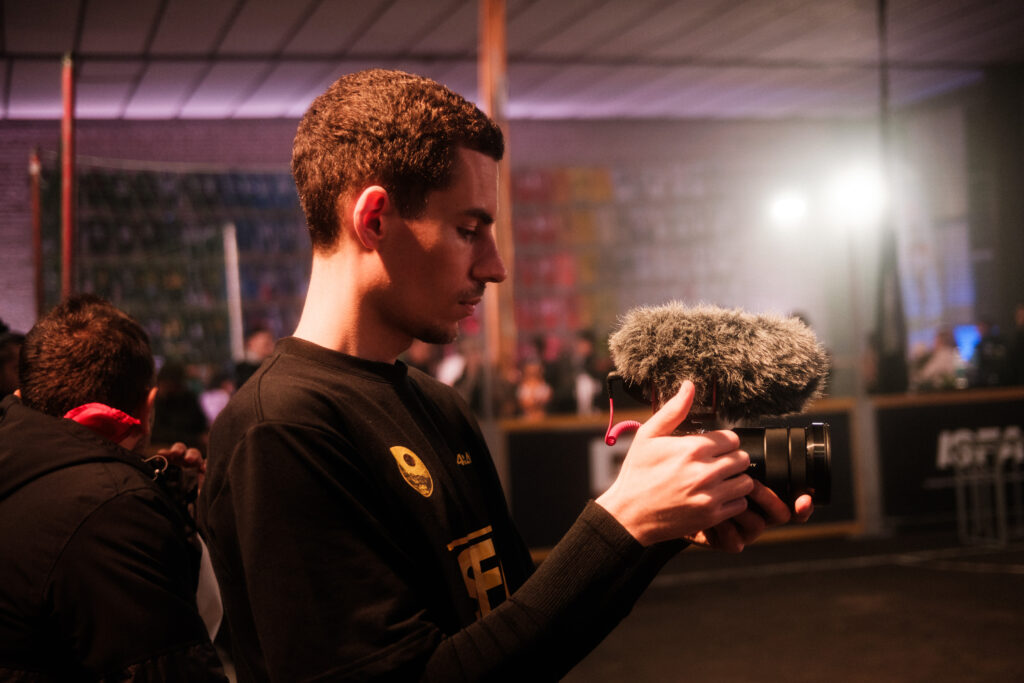
The opening match was Croatia vs Japan, with the first-ever World Cup goal scored by Kato after an assist from the tournament’s oldest player, Hata. In Serbia vs Colombia, we saw the first penalty after a DOGSO (Denying an Obvious Goal-Scoring Opportunity) situation by Alejo, with Igor converting it with ice-cold precision.
At one point, the power went out, disrupting the livestream. As I was filming from the opposite side of the pitch, I started receiving texts and calls from people watching at home, asking what had happened. Fortunately, that issue was quickly resolved.
A problem that was a little more difficult to solve: Pitch 2 becoming dangerously slippery. The recently applied chalk lines hadn’t dried before players stepped onto the pitch, causing the chalk to spread and reduce traction. Looking back, a more detailed planning would have helped avoiding this.
Games concluded around 9:30 PM. Josh provided livestream commentary for all matches on Pitch 1, which made his voice very hoarse. For day two, we would extend the commentary booth and add microphones for Julian and Jack (who had been eliminated with England in the group stage).
At the end of the day, we took a group photo of the last men standing, posted the group standings with five out of seven games played and filmed a recap video reflecting on day one. Back at our Airbnb, we ordered pizza and had some late-night talks.
Saturday, November 2: World Cup Day 2 - Knockout Stage
Overnight, we fixed the slippery court by adding sand to absorb the moisture. By 10 AM, teams arrived and by 10:30 AM, the gates opened to fans. The remaining group stage matches began, with Kyrgyzstan playing all seven games in one day, coming heartbreakingly close to qualifying for the knockout stage.
One of the most controversial moments occurred in the “Battle of the Balkans” between Serbia and Bosnia, where a goal/no-goal situation highlighted a problem in our goal design – vertical bars instead of horizontal ones. While the use of VAR was effective, it was still somewhat improvised. Moving forward, I plan to make the Video Support process more structured.
The most-watched game? Probably Brazil vs USA. Brazil had already been eliminated and couldn’t qualify for the knockout stage, so they played purely for the cameras, putting on a show embodying true “Joga Bonito.” One video from that match currently has 12M views across Instagram and TikTok.
My personal favourite goal? Enis securing Germany’s spot in the knockout stage with a last-second winning goal against direct rivals China. In a 3v2 situation, he pulled off his signature move – the Air Akka – executing it flawlessly and exactly as planned. Stay tuned to find out if it actually became goal of the tournament.
After the group stage wrapped up at 2 PM, we posted the final standings and the Round of 16 kicked off with Nenad doing interviews with the players on the livestream in between the games. Ghetto proved once again they are the best at fan interaction between matches. There was a crossbar challenge, a rapper performance, a freestyle show featuring Yorok, Andreas and Franek. Gui even took on a fan in a 1v1 match and we sold a “mystery box” – initially revealed to be empty, only for the lucky winner to walk away with two signed jerseys from the tournament finalists. Luckily we had no Ghetto Tinder this time.
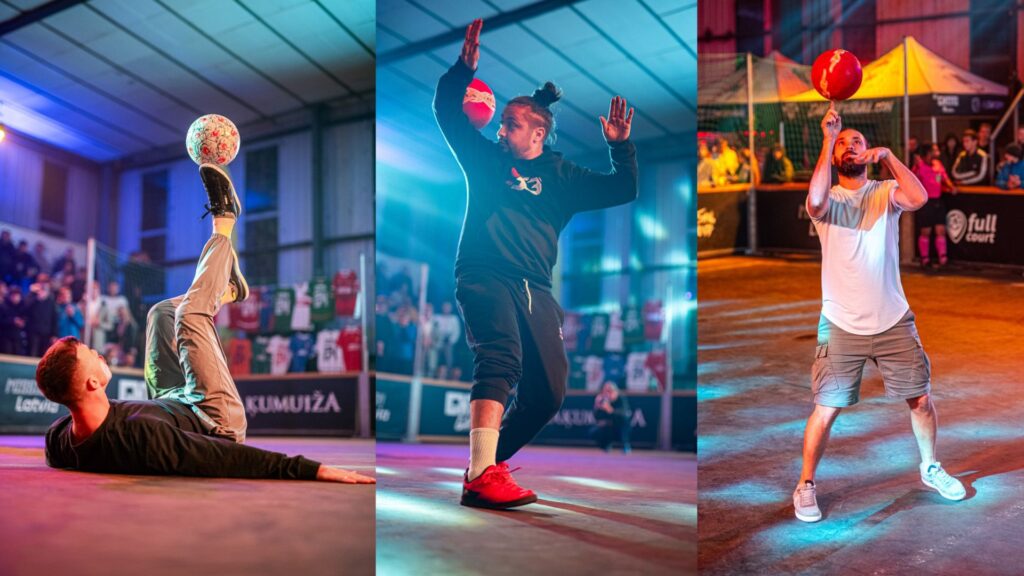
The first 1v1 Golden Goal in extra time came in the Finland vs Latvia clash, where Mohammad Ahmadi sealed the win, eliminating the host nation. Personally, I love the intensity of these high-stakes moments. I was happy this tournament featured four of them.
By 4 PM, we reached the quarter-finals. The top 8 teams were: Austria, Denmark, Finland, Belgium, Serbia, Colombia, USA, and the Netherlands.
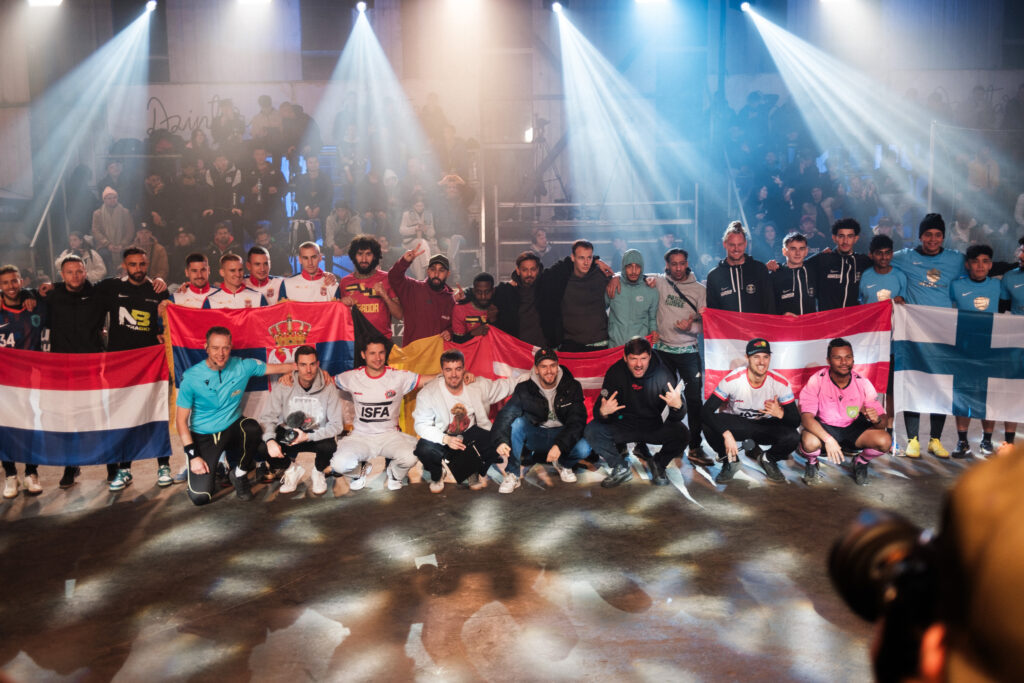
The whole knockout phase was filled with thrillers of matches. One of the wildest moments came in the Austria vs Denmark quarter-final. After scoring one of the most spectacular goals of the tournament, Amin showed Fedi a middle finger. The result of a crazy game with multiple yellow cards. If the tension goes high, emotions run up.
Before the finals, the ISFA leadership team was honoured by Antons and Raimonds.
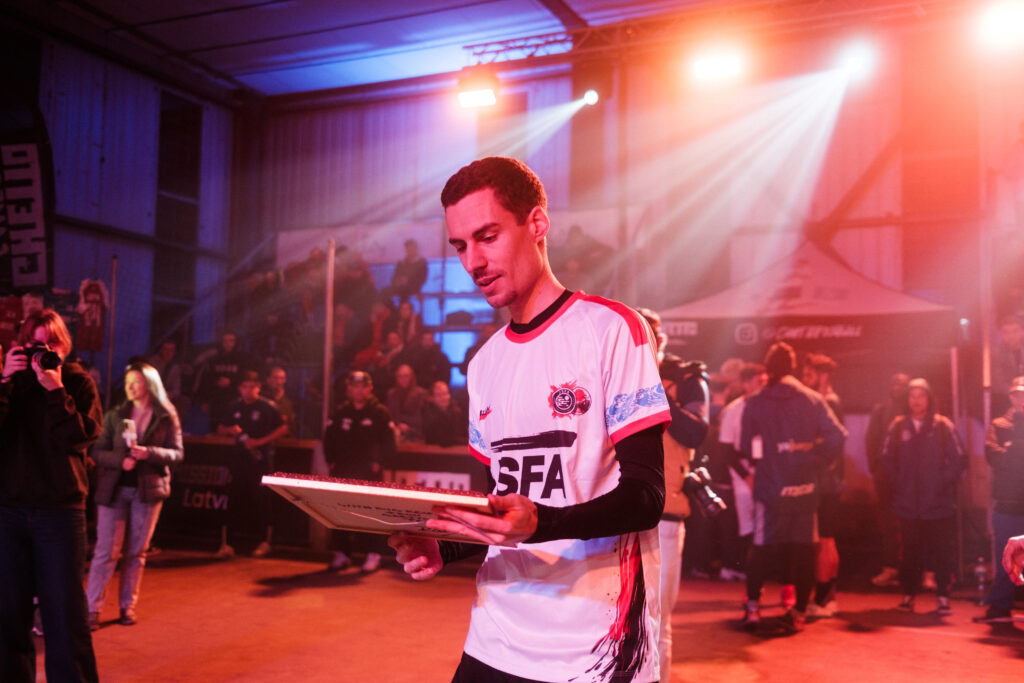
For the third-place match, Pannahouse (Denmark) had two “injured” players and initially hesitated to play. Many teams in tournaments skip the third-place match due to disappointment and/or time constraints. In Hamburg, we once played for third place after the tournament, with the loser buying kebab for the winner. This time, I insisted on playing the 3rd Place Game as it was the first official World Cup and a full ranking was necessary. Ultimately, Denmark let the US take third place and the match became a show game, featuring Jorge from Colombia as a guest player, random dance break included.
At 7 PM, it was time for the grand finale: Joga3 (Belgium) vs StreetKings (Netherlands). Both teams played cautiously, knowing that one mistake could cost them the title. Each had one major chance, but regular time ended with a goggles score 0-0.
But let’s be honest. What’s a better way to decide the first ISFA World Champions in a breath-taking 1V1 between the 2 best players of the tournament: Jim Nelen (NL) vs George Ntiamoah (BE)?
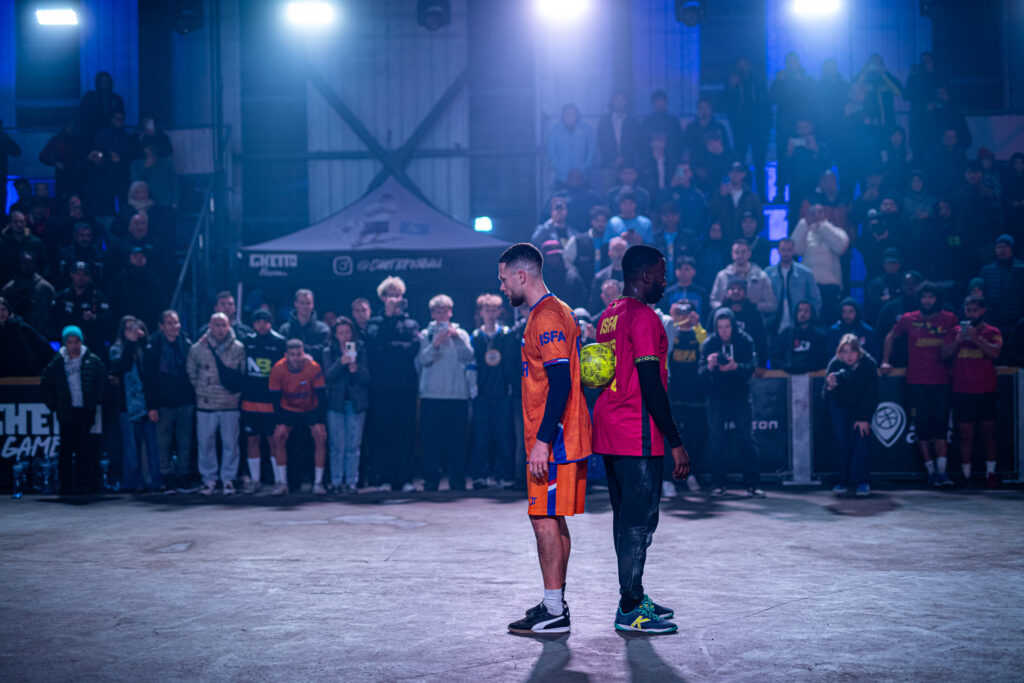
And the winner is… StreetKings (Netherlands). Jim Nelen, Zohair Arbib, Ufuk Ulker and Nikzad Mahbobi, led by coach Edward van Gils, demonstrated the perfect blend of tactics and skills, proving once again that modern street football is born in Amsterdam.
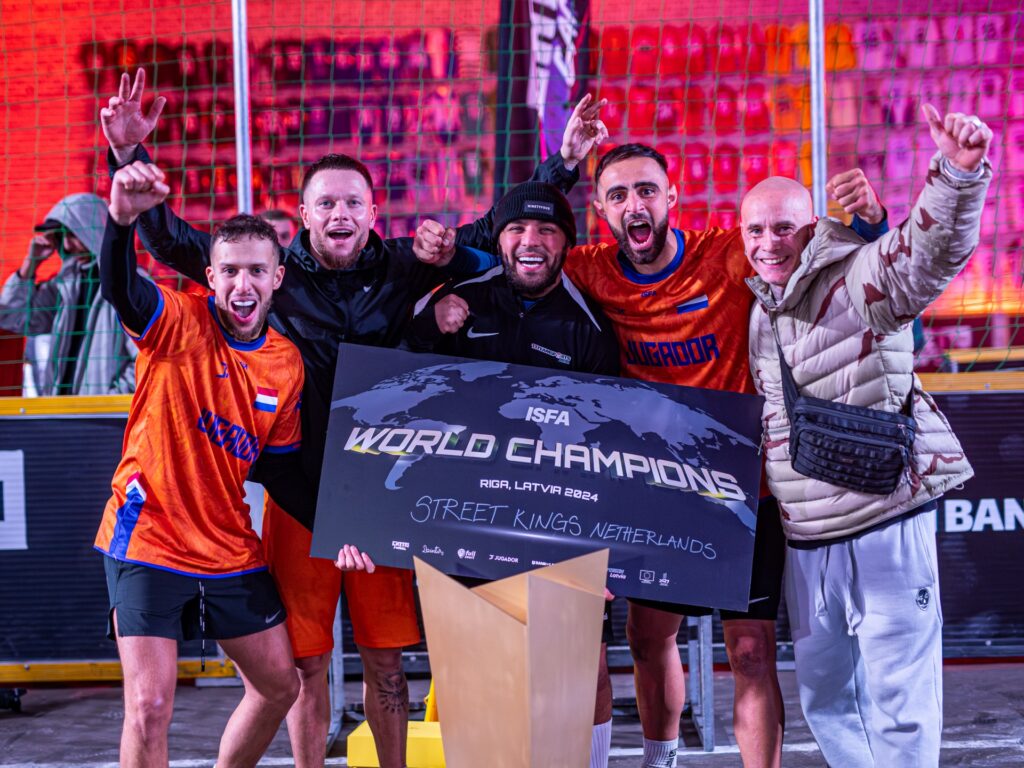
On the way back to the Airbnb, we vibed to “Freestyler“ by Bomfunk MC’s blasting from the radio in the Bolt – a song that now instantly brings back memories. The same goes for “I Gotta Feeling” by Black Eyed Peas, but for an entirely different reason: Jovan grabbing the mic during the final and shouting, “DJ, turn off this song and play something street!” He probably didn’t know we have a tradition of playing “Mas Que Nada” in de final of, yes you guessed it rigth, the same Black Eyed Peas featuring Sérgio Mendes.
At the afterparty, Jovan, Josh, and I sat together and made it official: we changed our group chat name from Free The Street to Freed The Street. Step one was completed – we proved that we don’t need the big brands to organize a massive event. Now that we have the proof of concept, the possibilities are endless. Stay tuned and brace yourself for what’s coming next, because this was just the beginning. We haven’t even started yet. We hit Angars first, then Pjji. In between, we sang “Bella Ciao,” and some made it to the after-after-after party. But what happens in Riga… stays in Riga.
Sunday, November 3: Wrapping Up and Heading Home
Around noon, we gathered for lunch at LIDO Vermanitis, sharing good conversations before saying goodbye. I headed home exhausted but fulfilled – this event was everything we ever dreamed of.
Those who stayed a few days longer in Riga visited the Ghetto Games Arena on Monday and explored more of the city’s Old Town.
Meanwhile, back in Serbia, the team that finished in 5th place received a hero’s welcome from their friends and family, who had been following the livestream, celebrating them like true champions with Bengal fire.
Recognizing the Best: ISFA Awards
To ensure the community had a voice, we sent out evaluation forms after the tournament, allowing players and organizers to give feedback and nominate candidates for the ISFA Awards. We selected the MV3’s (the three most valuable players, nice one Josh) of the tournament – because picking just one wasn’t enough – and opened public voting for the other awards. Here are the winners:
MV3's: Jim Nelen, George Ntiamoah, Eduardo Garay
Goal of the Tournament: Enis Djebbi vs China, speaks for itself.
Rising Star Award: Jorge Atehortua, a raw diamond from Colombia.
Defender of the Tournament: Igor Kudric, the Serbian Wall, blocking every shot and defending with an enormous amount of passion.
Vibes Award: Spain who brought 40+ fans to Riga.
Skiller of the Tournament: Jacob Corneliusen, if you see him play for the first time, your mouth will fall open of his unique style.
Panna of the Tournament: Bob Diasonama vs Bosnia, approved by Groundfather Liicht.
Shoutouts
I want to thank my partners in crime in the ISFA leadership team: Jovan Gruban, Antons Semenaks, Kristoffer P. Liicht, Josh Dean, Nenad Gruban, Santiago Rodriguez, Edward van Gils and Jack Downer. It’s been a wild ride – 1.5 years since I joined this project, and we’ve been laying the groundwork to build the ISFA network. What we accomplished here is a testament to passion, respect and love for the game.
Huge shoutout to Laura for designing all the stunning social media graphics and YouTube thumbnails. Honestly, I don’t think I’ve seen better thumbnails on sports videos – her work is next level.
This all wouldn’t have been possible without the dedication of our community leaders, volunteers, referees, photographers, camera crew, DJs, livestreamers, commentators, light technicians, content creators, graphic designers, players and fans. To use Jack’s words: y’all the real MVPs.
World Cup Ranking
The first-ever ISFA ranking looks as follows:
| Rank | Team | Country | Points Awarded |
|---|---|---|---|
| 1 | STREETKINGS | 🇳🇱 Netherlands | 2000 |
| 2 | JOGA 3 | 🇧🇪 Belgium | 1500 |
| 3 | SAN DIEGO FC | 🇺🇸 USA | 1200 |
| 4 | PANNAHOUSE | 🇩🇰 Denmark | 1100 |
| 5 | KINGS OF KLESSHEIM | 🇦🇹 Austria | 750 |
| YÖKORIS | 🇫🇮 Finland | 750 | |
| SOLAR – M | 🇷🇸 Serbia | 750 | |
| MEDELLIN CALLEJEROS | 🇨🇴 Colombia | 750 | |
| 9 | STREETSOCCERHH | 🇩🇪 Germany | 500 |
| BOJANOMUNDIAL | 🇮🇹 Italy | 500 | |
| NIKE STRIKE | 🇱🇻 Latvia | 500 | |
| AEFC | 🇪🇸 Spain | 500 | |
| PRIJEDOR | 🇧🇦 Bosnia | 500 | |
| STREET MASTERS | 🇨🇱 Chile | 500 | |
| S3 | 🇫🇷 France | 500 | |
| GENNECY BRICKS | 🇨🇭 Switzerland | 500 | |
| 17 | FC SAN ANDREAS | 🇰🇬 Kyrgyzstan | 100 |
| STREET JAPAN | 🇯🇵 Japan | 100 | |
| STREET SOUL CHINA | 🇨🇳 China | 100 | |
| KINGS5S | 🇬🇧 UK | 100 | |
| STREET CITY AU | 🇦🇺 Australia | 100 | |
| PANNA NEPAL | 🇳🇵 Nepal | 100 | |
| GOATS | 🇲🇽 Mexico | 100 | |
| STREETS OF SWEDEN | 🇸🇪 Sweden | 100 | |
| GUINNESS | 🇮🇪 Ireland | 100 | |
| R-STYLE | 🇵🇱 Poland | 100 | |
| PULINHO STREET | 🇧🇷 Brazil | 100 | |
| STREET PHARAOHS | 🇪🇬 Egypt | 100 | |
| MATINA EKIPA | 🇭🇷 Croatia | 100 | |
| PANNA STUDIO | 🇰🇷 South Korea | 100 |
More from the ISFA World Cup
Rewatch Games: More on ISFA YouTube
Photo Gallery: More on Ghetto Games
Aftermovie:
Aftertalk with Jovan and Antons:
Behind-the-scenes Documentary:
ISFA World Cup in Numbers
Looking back, here are some numbers I’m very proud of: We livestreamed the event with English, Spanish and Chinese commentary, gathering 175,000 live views over the two event days. The full games have now been watched 1.6 million times and the highlight reels have racked up over 110 million views across social media.
If you made it this far, thanks a lot for reading! I hope you learned some interesting insights of our journey behind the scenes. Now I need a month of sleep to catch up from this hectic period. Catch you all at the next event. Peace out!
Vince
PS: The ISFA 3V3 Street Football World Tour ’25/26 is already in preparation for the next World Cup in 2026.

